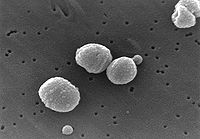
Polysaccharide encapsulated bacteria
Encyclopedia

Microorganism
A microorganism or microbe is a microscopic organism that comprises either a single cell , cell clusters, or no cell at all...
, are a group of bacteria
Bacteria
Bacteria are a large domain of prokaryotic microorganisms. Typically a few micrometres in length, bacteria have a wide range of shapes, ranging from spheres to rods and spirals...
that have an outer covering, a bacterial capsule, made of polysaccharide
Polysaccharide
Polysaccharides are long carbohydrate molecules, of repeated monomer units joined together by glycosidic bonds. They range in structure from linear to highly branched. Polysaccharides are often quite heterogeneous, containing slight modifications of the repeating unit. Depending on the structure,...
.
Examples of encapsulated bacteria
- Haemophilus influenzae type bHaemophilus influenzaeHaemophilus influenzae, formerly called Pfeiffer's bacillus or Bacillus influenzae, Gram-negative, rod-shaped bacterium first described in 1892 by Richard Pfeiffer during an influenza pandemic. A member of the Pasteurellaceae family, it is generally aerobic, but can grow as a facultative anaerobe. H...
(Hib) - Streptococcus pneumoniaeStreptococcus pneumoniaeStreptococcus pneumoniae, or pneumococcus, is Gram-positive, alpha-hemolytic, aerotolerant anaerobic member of the genus Streptococcus. A significant human pathogenic bacterium, S...
(pneumococcus) - Neisseria meningitidisNeisseria meningitidisNeisseria meningitidis, often referred to as meningococcus, is a bacterium that can cause meningitis and other forms of meningococcal disease such as meningococcemia, a life threatening sepsis. N. meningitidis is a major cause of morbidity and mortality during childhood in industrialized countries...
(meningococcus) - Group B streptococcusGroup B StreptococcusInfection with Group B Streptococcus , also known as 'Streptococcus agalactiae' and more colloquially as Strep B and group B Strep, can cause serious illness and sometimes death, especially in newborn infants, the elderly, and patients with compromised immune systems...
(GBS) - Klebsiella pneumoniaeKlebsiella pneumoniaeKlebsiella pneumoniae is a Gram-negative, non-motile, encapsulated, lactose fermenting, facultative anaerobic, rod shaped bacterium found in the normal flora of the mouth, skin, and intestines....
- Salmonella typhi
Role in disease
Many encapsulated bacteria are pathogens that lead to a significant amount of morbidity and mortalityDeath
Death is the permanent termination of the biological functions that sustain a living organism. Phenomena which commonly bring about death include old age, predation, malnutrition, disease, and accidents or trauma resulting in terminal injury....
. Encapsulated bacteria are antiphagocytic and hence are susceptible to antibody mediated immune response (B cells) as opposed to cell mediated immune response. B cell
B cell
B cells are lymphocytes that play a large role in the humoral immune response . The principal functions of B cells are to make antibodies against antigens, perform the role of antigen-presenting cells and eventually develop into memory B cells after activation by antigen interaction...
deficiencies are highly susceptible to encapsulated bacterial infections.
Asplenia
People that lack a spleenSpleen
The spleen is an organ found in virtually all vertebrate animals with important roles in regard to red blood cells and the immune system. In humans, it is located in the left upper quadrant of the abdomen. It removes old red blood cells and holds a reserve of blood in case of hemorrhagic shock...
, functionally (as in sickle cell disease) or anatomically (due to a splenectomy
Splenectomy
A splenectomy is a surgical procedure that partially or completely removes the spleen.-Indications:The spleen, similar in structure to a large lymph node, acts as a blood filter. Current knowledge of its purpose includes the removal of old red blood cells and platelets, and the detection and fight...
or congenital absence), have been shown to be more susceptible to these pathogens. Therefore, it is standard medical practise to recommend vaccination.
It is generally recommended that people with asplenia
Asplenia
Asplenia refers to the absence of normal spleen function and is associated with some serious infection risks. Hyposplenism is used to describe reduced splenic functioning, but not as severely affected as with asplenism.-Congenital:...
are vaccinated
Vaccine
A vaccine is a biological preparation that improves immunity to a particular disease. A vaccine typically contains an agent that resembles a disease-causing microorganism, and is often made from weakened or killed forms of the microbe or its toxins...
against Neisseria meningitis, Haemophilus influenzae, and Streptococcus pneumoniae. These vaccines can be remembered with the mnemonic
Mnemonic
A mnemonic , or mnemonic device, is any learning technique that aids memory. To improve long term memory, mnemonic systems are used to make memorization easier. Commonly encountered mnemonics are often verbal, such as a very short poem or a special word used to help a person remember something,...
: SHiN.

